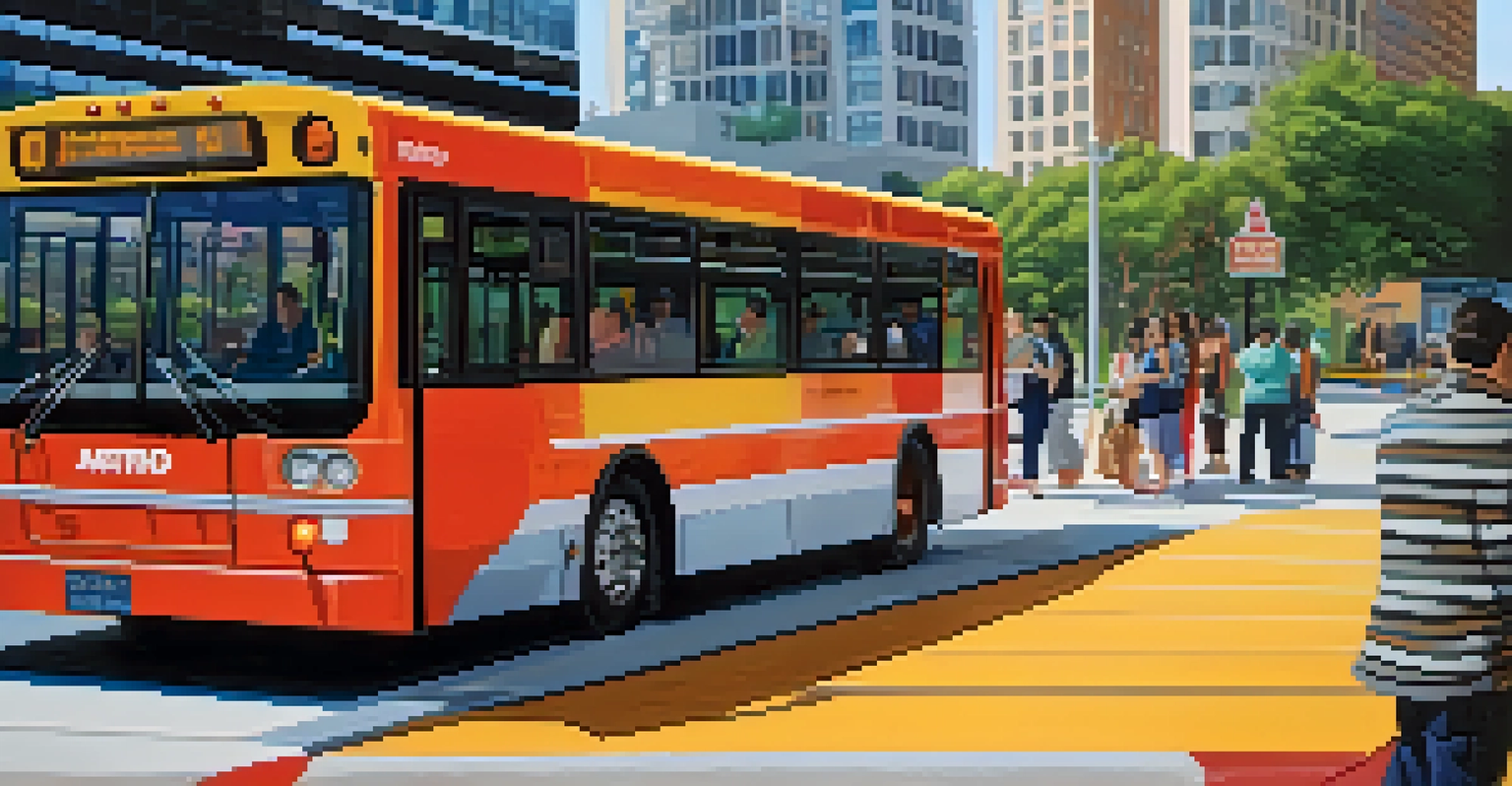Public Transit in Houston: Innovations and Future Developments

Overview of Public Transit in Houston: A Current Snapshot
Houston's public transit system is a bustling network that serves millions of residents and visitors each year. With a combination of buses, light rail, and paratransit services, it aims to provide accessible transportation options across the sprawling city. The Metropolitan Transit Authority of Harris County (METRO) oversees these services, striving to meet the diverse needs of the community.
Public transportation is a lifeline for communities, providing access to jobs, education, and essential services.
Despite its growth, the public transit system faces challenges such as traffic congestion and limited coverage in suburban areas. Many residents rely on personal vehicles, which can lead to increased pollution and road strain. However, the city is actively working to address these issues and improve overall accessibility.
In recent years, there has been a push for more sustainable solutions, highlighting the need for innovative strategies that incorporate technology and community feedback. As Houston continues to evolve, understanding the current landscape of public transit is crucial for planning future developments.
Innovations in Public Transit: Technology and Sustainability
One of the most exciting developments in Houston's public transit is the integration of technology to enhance rider experience. Real-time tracking apps provide passengers with up-to-date information on bus and train arrivals, reducing wait times and improving reliability. This tech-savvy approach not only makes commuting easier but also encourages more people to utilize public transport.

Additionally, Houston is making strides in sustainability by exploring electric buses and cleaner energy sources. These initiatives aim to reduce the carbon footprint of public transit, aligning with global efforts to combat climate change. By investing in greener options, the city hopes to attract environmentally-conscious riders.
Houston Transit: A Growing Network
Houston's public transit system is evolving with technology and sustainability efforts to better serve its diverse communities.
Innovative programs, such as bike-sharing initiatives and partnerships with rideshare companies, are also being implemented. These efforts create a more integrated transportation network, making it easier for residents to choose public transit as a viable alternative to driving.
Enhancing Accessibility: Focus on Diverse Communities
Accessibility is a key focus for Houston's public transit developments, particularly for individuals with disabilities and those in underserved communities. METRO is actively working to ensure that all transit options are compliant with the Americans with Disabilities Act (ADA), providing features like low-floor buses and accessible stations. This commitment reflects a broader goal of inclusivity in urban planning.
A robust public transit system is essential for reducing traffic congestion and improving the quality of life in urban areas.
Community engagement plays a vital role in understanding the unique needs of different neighborhoods. METRO often collaborates with local organizations to gather feedback, ensuring that transit improvements are aligned with what residents truly want. This participatory approach fosters trust and demonstrates that the city values its residents' voices.
Furthermore, the expansion of services to historically underserved areas is vital for economic growth and social equity. By enhancing access to public transit in these regions, more residents can reach job opportunities, educational institutions, and essential services, ultimately improving quality of life.
Future Developments: Plans for Expansion and Improvement
Looking ahead, Houston has ambitious plans to expand its public transit network significantly. Upcoming projects include the extension of light rail lines and the introduction of bus rapid transit (BRT) corridors, which promise to provide faster and more efficient service. These expansions are designed to better connect different parts of the city and reduce reliance on personal vehicles.
Additionally, the city is exploring innovative funding strategies to support these developments. Public-private partnerships and grants from governmental agencies could provide the necessary resources to bring these projects to fruition. Creative financing will be crucial for realizing Houston's vision of a robust public transit system.
Focus on Community Engagement
Active involvement of residents in transit planning ensures that the system meets the unique needs of different neighborhoods.
As these plans unfold, it's essential for residents to stay informed and engaged. Public meetings and forums provide opportunities for community input and help ensure that the transit system evolves in ways that meet the needs of all Houstonians.
Public Transit and Urban Development: A Symbiotic Relationship
Public transit systems and urban development go hand in hand, influencing each other's growth and success. In Houston, effective transit can lead to denser, mixed-use developments that create vibrant communities. As more people opt for public transportation, cities can reduce the need for expansive parking areas and improve the overall urban landscape.
Zoning policies that encourage transit-oriented development (TOD) are gaining traction in Houston. By allowing for residential and commercial spaces near transit hubs, the city can create a more walkable and convenient environment. This approach not only benefits commuters but also stimulates local economies.
The relationship between transit and urban development is a win-win; improved public transit attracts new residents and businesses, while a growing population can justify further transit investments. As Houston continues to grow, fostering this synergy will be crucial for creating a sustainable and livable city.
Community Engagement: Involving Residents in Transit Planning
Community engagement is critical for the success of public transit initiatives in Houston. Residents' insights and experiences can provide valuable information that guides planning and decision-making processes. METRO has made strides in involving the community through surveys, public meetings, and outreach programs, ensuring that diverse voices are heard.
By actively soliciting feedback, the city can identify areas for improvement and prioritize projects that matter most to residents. This collaborative approach fosters a sense of ownership among community members, making them more likely to utilize and advocate for public transit options.
Future Expansion Plans Ahead
Ambitious plans for expanding light rail and bus services aim to improve connectivity and reduce reliance on personal vehicles.
Moreover, involving the community in transit planning helps to build trust and transparency between city officials and residents. As people see their suggestions being implemented, they feel more connected to the city's transit system and are encouraged to participate in future discussions.
Conclusion: The Future of Public Transit in Houston
The future of public transit in Houston is bright, with numerous innovations and developments on the horizon. By embracing technology, focusing on sustainability, and emphasizing community engagement, the city is poised to create a more efficient and inclusive transit system. These efforts are not just about transportation; they are about enhancing the quality of life for all residents.
As Houston continues to grow, the importance of a robust public transit system will only increase. The city must remain committed to investing in and improving transit options to meet the needs of a diverse population. This commitment will help reduce traffic congestion, lower emissions, and provide equitable access to essential services.

In conclusion, public transit is more than a means of getting from point A to point B; it is a lifeline for communities. By prioritizing innovation and collaboration, Houston can pave the way for a future where public transit is a preferred choice for all residents.